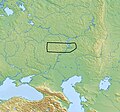 | Early Slavs (section Culture-historical viewpoint) BC–1st century AD culture geographically located in northwestern Ukraine and southern Belarus. According to the Chernoles culture theory, the pre-Proto-Slavs... 127 KB (15,621 words) - 21:06, 19 April 2024 |
 | Przeworsk culture (Middle and Upper Vistula with Rightbank Oder) Chernoles culture (Pripyat' basin, Middle Dnieper and part of Upper Dnieper) Theory... 3 KB (157 words) - 01:18, 19 September 2023 |
 | Komarov culture was a Bronze Age culture which flourished along the middle Dniester from 1500 BC to 1200 BC. Few settlements from the Komarov culture have... 2 KB (183 words) - 17:23, 10 October 2023 |
on the territories of contemporary Belarus, Russia, and Ukraine. Clan cultures of the Stone Age and Bronze Age, up to the Late Antiquity period of the... 41 KB (1,356 words) - 08:54, 19 April 2024 |
 | 49.551376°E / 52.741254; 49.551376 The Khvalynsk culture is a Middle Copper Age Eneolithic culture (c. 4,900 – 3,500 BC) of the middle Volga region.... 14 KB (1,726 words) - 10:01, 11 April 2024 |
 | The Abashevo culture (Russian: Абашевская культура, romanized: Abashevskaya kul'tura) is a late Middle Bronze Age archaeological culture, ca. 2200–1850... 25 KB (2,936 words) - 17:15, 15 April 2024 |
 | The Andronovo culture is a collection of similar local Late Bronze Age cultures that flourished c. 2000–1150 BC, spanning from the southern Urals to the... 63 KB (7,041 words) - 15:09, 4 May 2024 |
 | Maykop culture (Russian: майкоп, [mɐjˈkop], scientific transliteration: Majkop,), c. 3700 BC–3000 BC, is a major Bronze Age archaeological culture in the... 22 KB (2,637 words) - 10:03, 11 April 2024 |
 | The Samara culture is an Eneolithic (Copper Age) culture dating to the turn of the 5th millennium BCE, at the Samara Bend of the Volga River (modern Russia)... 13 KB (1,332 words) - 13:13, 2 May 2024 |
Afanasievo culture, or Afanasevo culture (Afanasevan culture) (Russian: Афанасьевская культура Afanas'yevskaya kul'tura), is an early archaeological culture of... 62 KB (6,043 words) - 04:42, 11 May 2024 |
 | The Usatove culture (Usatove in Ukrainian, Usatovo in Russian) is an Eneolithic group of the North Pontic region with influences from the Cucuteni–Trypillia... 8 KB (703 words) - 13:15, 2 May 2024 |
 | lower section there are important discovery sites of the Bilogrudivka/Chernoles culture near the settlement of Subotiv. These findings represent key late... 2 KB (149 words) - 16:26, 28 March 2024 |
 | The Globular Amphora culture (GAC, German: Kugelamphoren-Kultur (KAK); c. 3400–2800 BC, is an archaeological culture in Central Europe. Marija Gimbutas... 9 KB (1,075 words) - 12:41, 11 May 2024 |
 | The Tazabagyab culture is from the late Bronze Age, ca. 1850 BC to 1500 BC, and flourished in the lower Zeravshan valley, as well as along the lower Amu... 9 KB (885 words) - 11:09, 8 April 2024 |
 | The Suvorovo (Suvorove in Ukrainian) culture, part of the Suvorovo-Novodanilovka group, was a Copper Age culture which flourished on the northwest Pontic... 5 KB (683 words) - 13:14, 2 May 2024 |
 | The Sintashta culture is a Middle Bronze Age archaeological culture of the Southern Urals, dated to the period c. 2200–1900 BCE. It is the first phase... 46 KB (4,900 words) - 19:11, 27 April 2024 |
 | Sarmatians (redirect from Sarmatian culture) of the Eurasian Steppe, the Sarmatians were part of the wider Scythian cultures. They started migrating westward around the fourth and third centuries... 80 KB (8,681 words) - 19:12, 19 April 2024 |
 | Temple ring (category Culture of Kievan Rus') was found in the Catacomb culture, Únětice culture and Karasuk culture. Later they were also found in the Chernoles culture. Temple rings were most popular... 7 KB (341 words) - 16:03, 22 March 2024 |












